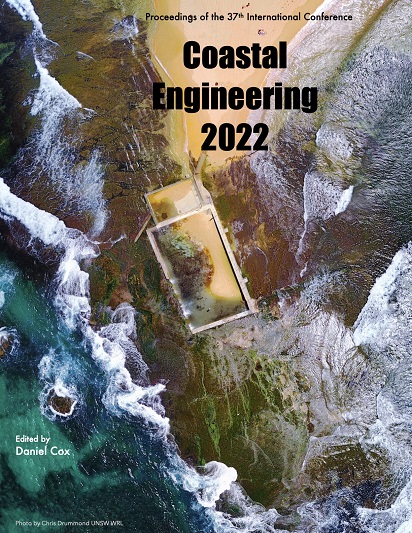Abstract
Onshore wind can significantly affect wave overtopping process and increase mean overtopping discharge. Thus, the wind should be an important variable in coastal design process. However, despite many researches have analyzed the influence of wind on the overtopping, there is still a lack of exhaustive knowledge about this phenomenon. To further analyze the wind effects, the CFD model FLOW-3D has been used to investigate wave overtopping at vertical seawalls. The single-fluid approach has been adopted, i.e. the presence of wind has been simulated via the wind shear stress on the sea surface. The main aim of this work is to verify the ability of this simplified numerical modelling to capture the macro-processes involved in the phenomenon of wave overtopping. The presence of wind shear stress has led to physically consistent results. It confirmed that as the mean overtopping discharge decreases, as the wind effect increases. Furthermore, numerical results have shown that the advection of water droplets behind the structure by the wind is the key mechanism for the enhancement of wave overtopping. Finally, by gathering numerical results and laboratory data carried out by Durbridge (2021), a new predictive formula to estimate the wind factor is provided.References
Andreas, E.L., L. Mahrt, D. Vickers. 2012. A New Drag Relation for Aerodynamically Rough Flow over the Ocean, Journal of the Atmospheric Sciences, 2520–2537.
Bretschneider, CL. 1964. Generation of waves by wind: state of art. Presented at International Summer Course, Lunteren, Netherlands. September 1- 18.
Buccino, M., M. Daliri, F. Dentale, A. Di Leo, M. Calabrese. 2019a. CFD experiments on a low crested sloping top caisson breakwater. Part 1. nature of loadings and global stability, Ocean Engineering, 182, 259–282.
Buccino, M., M. Daliri, F. Dentale, M. Calabrese, 2019b. CFD experiments on a low crested sloping top caisson breakwater. Part 2. Analysis of plume impact. Ocean Engineering, 173, 345–357.
Dentale, F., F. Reale, A. Di Leo, E. Pugliese Carratelli. 2018. A CFD approach to rubble mound breakwater design. International Journal of Naval Architecture and Ocean Engineering, 10(5), pp. 644–650.
de Waal, J.P., P. Tönjes, J. van der Meer. 1996. Wave overtopping of vertical structures including wind effect, Proceedings of the 25th International Conference on Coastal Engineering, ASCE, Orlando, FL, USA, 2–6 September 1996.
Di Leo, A., M. Buccino, F. Dentale, E. Pugliese Carratelli. 2022a. CFD Analysis of Wind Effect on Wave Overtopping, Proceedings of the 32nd International Ocean and Polar Engineering Conference, Shanghai, China, 5–10 June 2022.
Di Leo, A., F. Dentale, M. Buccino, S. Tuozzo, E. Pugliese Carratelli. 2022b. Numerical Analysis of Wind Effect on Wave Overtopping on a Vertical Seawall, Water, 14, 3891.
Durbridge, S. 2021. The effect of onshore wind on wave overtopping of a vertical sea wall. Plymouth Stud. Sci., 14, 311–355.
Fenton, J.D. Numerical Methods for Nonlinear Waves, Advances in Coastal and Ocean Engineering, Liu, P.L.-F., Ed.; World Scientific: Singapore, 1999; Volume 5, pp. 241–324.
Flow Science, Inc. FLOW-3D User’s Manual, HYDRO ed.; Flow Science, Inc.: Santa Fe, NM, USA, 2022.
Hieu, P.D., P.N. Vinh, D.V. Toan, N.T. Son. 2014. Study of Wave-wind Interaction at a Seawall Using a Numerical Wave Channel, Applied Mathematical Modelling, 38, 5149–5159.
Hirt, C.W., and B.D. Nichols. 1981. Volume of fluid (VOF) method for the dynamics of free boundaries, Journal of Computational Physics, 39, 201–225.
Hirt, C.W., and J.M. Sicilian. 1985. A porosity technique for the definition of obstacles in rectangular cell meshes, Proceedings of the Fourth International Conference of Ship Hydrodynamics, National Academy of Science, Washington, DC, USA, 24–27 September 1985.
Kiku, M., and K. Kawasaki. 2014. Proposal of numerical wave flume for wave overtopping computation considering wind external force, Proceedings of 34th Conference on Coastal Engineering, Seoul, Republic of Korea, 15–20 June 2014.
Lopez, L.F.C., D. Salerno, F. Dentale, A. Capobianco, M. Buccino. 2015. Experimental campaign on the overtopping of the seawall Malecon Traditional, Proceeding of 25th International Ocean and Polar Engineering Conference, ISOPE Kona, Big Is-land, United States, 21-26 June 2015, pp. 1499-1505. Volume 2015-January
Lopez, L. F. C., D. Salerno, F. Dentale, A. Capobianco, Buccino, M. 2016. Wave overtopping at Malecòn tradicional, La Habana, Cuba. Coastal Engineering Proceedings, Antalya, Turkey, 17-20 November 2016, pp.24-24.
Murakami, K., D. Maki, K, Ogino. 2019. Effect of Wind Velocity on Wave Overtopping, Proceedings of the 10th International Conference on Asian and Pacific Coasts (APAC 2019), Hanoi, Vietnam: 25 – 28 September.
Perlin, M., C. Wooyoung, T. Zhigang, 2013. Breaking Waves in Deep and Intermediate Waters. Annual Review of Fluid Mechanics, 45, 115–145.
Pullen, T., W. Allsop, T. Bruce, J. Pearson. 2009. Field and laboratory measurements of mean overtopping discharges and spatial distributions at vertical seawalls, Coastal Engineering.
Resio, D.T. 1987. Assessment of Wind Effects on Wave Overtopping of Proposed Virginia Beach Seawall. Tech. Memo to CERC., OCTI.
Xie, Z. 2014. Numerical modelling of wind effects on breaking solitary waves, European Journal of Mechanics - B/Fluids, 43, 135–147.
Yakhot, V., L.M. Smith. 1992. The renormalization group, the ε-expansion and derivation of turbulence models, Journal of Scientific Computing, 7, 35.

This work is licensed under a Creative Commons Attribution 4.0 International License.
Copyright (c) 2023 Sara Tuozzo, Angela Di Leo, Mariano Buccino, Fabio Dentale, Eugenio Pugliese Carratelli, Mario Calabrese

